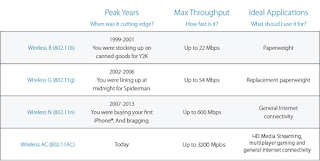The very first device that had fundamentally the same functionality as a router does today was the Interface Message Processor (IMP); IMPs were the devices that made up the ARPANET, the first packet network. The idea for a router (called "gateways" at the time) initially came about through an international group of computer networking researchers called the International Network Working Group (INWG). Set up in 1972 as an informal group to consider the technical issues involved in connecting different networks, later that year it became a subcommittee of the International Federation for Information Processing.[18]
These devices were different from most previous packet networks in two ways. First, they connected dissimilar kinds of networks, such as serial lines and local area networks. Second, they were connectionless devices, which had no role in assuring that traffic was delivered reliably, leaving that entirely to the hosts (this particular idea had been previously pioneered in the CYCLADES network).
The idea was explored in more detail, with the intention to produce a prototype system, as part of two contemporaneous programs. One was the initial DARPA-initiated program, which created the TCP/IP architecture in use today.[19]
The other was a program at Xerox PARC to explore new networking technologies, which produced the PARC Universal Packet system; due to corporate intellectual property concerns it received little attention outside Xerox for years.[20]
Some time after early 1974 the first Xerox routers became operational. The first true IP router was developed by Virginia Strazisar at BBN, as part of that DARPA-initiated effort, during 1975-1976. By the end of 1976, three PDP-11-based routers were in service in the experimental prototype Internet.[21]

The first multiprotocol routers were independently created by staff researchers at MIT and Stanford in 1981; the Stanford router was done by William Yeager, and the MIT one by Noel Chiappa; both were also based on PDP-11s.[22][23][24][25]
Virtually all networking now uses TCP/IP, but multiprotocol routers are still manufactured. They were important in the early stages of the growth of computer networking, when protocols other than TCP/IP were in use. Modern Internet routers that handle both IPv4 and IPv6 are multiprotocol, but are simpler devices than routers processing AppleTalk, DECnet, IP and Xerox protocols.
From the mid-1970s and in the 1980s, general-purpose mini-computers served as routers. Modern high-speed routers are highly specialized computers with extra hardware added to speed both common routing functions, such as packet forwarding, and specialised functions such as IPsec encryption.
There is substantial use of Linux and Unix software based machines, running open source routing code, for research and other applications. Cisco's operating system was independently designed. Major router operating systems, such as those from Juniper Networks and Extreme Networks, are extensively modified versions of Unix software.
 After putting in more than 250 total hours of research and testing, we recommend the $100 TP-Link Archer C7 (v2) router for most people right now. We tested it against more than 20 other routers over the past year and a half. Though this dual-band, three-stream wireless-ac router wasn’t always the fastest on every single one of our tests, it did provide great wireless performance and is offered at a super affordable price, which makes it an unbeatable value.
After putting in more than 250 total hours of research and testing, we recommend the $100 TP-Link Archer C7 (v2) router for most people right now. We tested it against more than 20 other routers over the past year and a half. Though this dual-band, three-stream wireless-ac router wasn’t always the fastest on every single one of our tests, it did provide great wireless performance and is offered at a super affordable price, which makes it an unbeatable value. Archer C7 usually costs between $80 and $100. That’s the same price as many older, slower routers, but it’s faster and able to cover a larger area than some routers that cost two to three times as much. It supports the top speeds of the latest wireless standard—wireless-ac—which means that any devices you connect to it will run as fast as they can. There’s no other router that does that and is as inexpensive as the Archer C7.
Archer C7 usually costs between $80 and $100. That’s the same price as many older, slower routers, but it’s faster and able to cover a larger area than some routers that cost two to three times as much. It supports the top speeds of the latest wireless standard—wireless-ac—which means that any devices you connect to it will run as fast as they can. There’s no other router that does that and is as inexpensive as the Archer C7.








